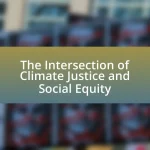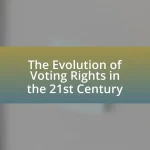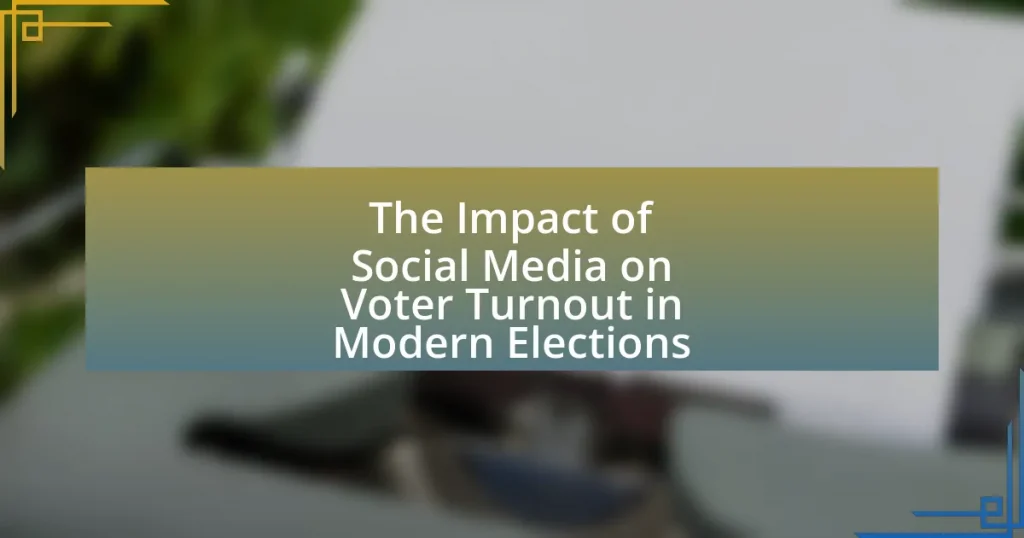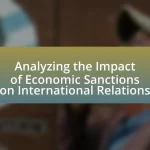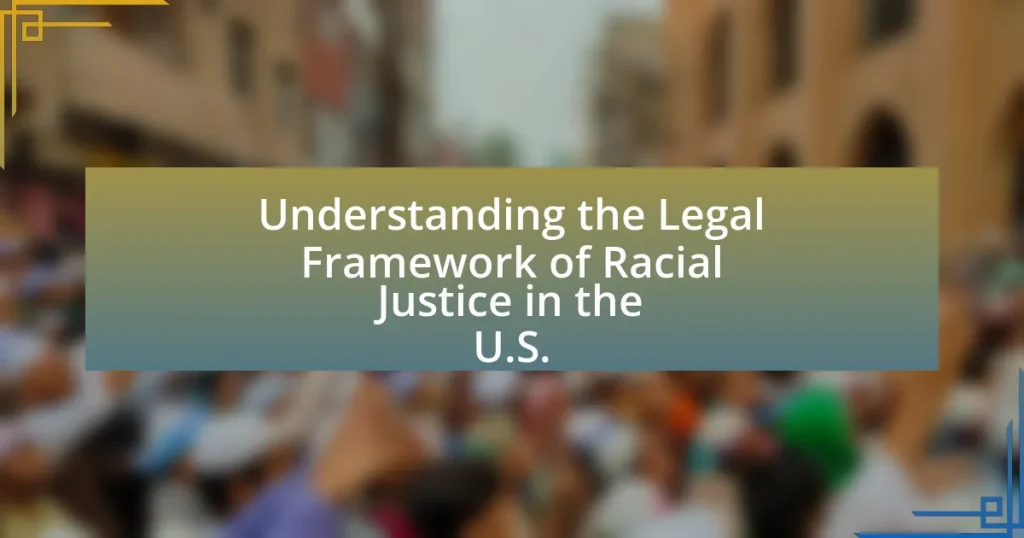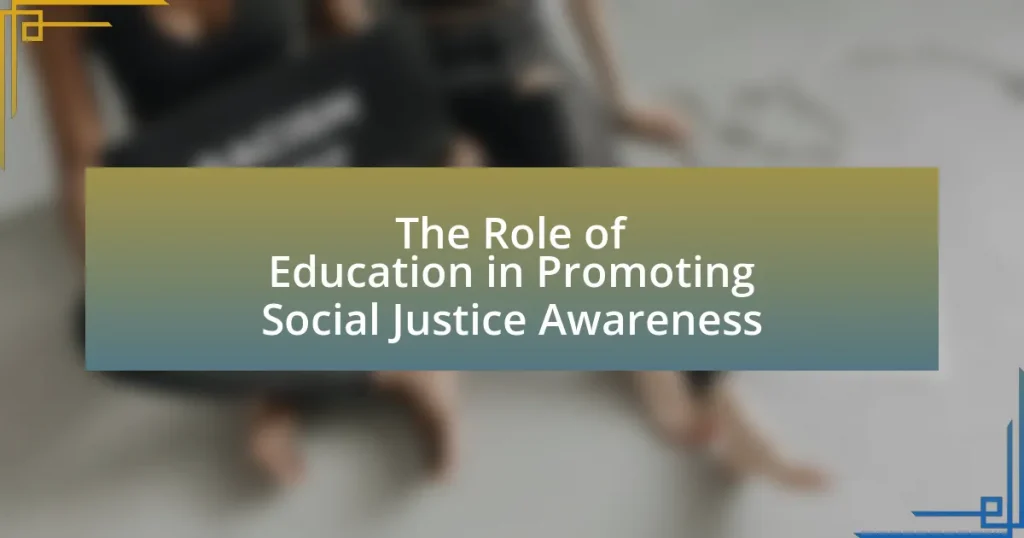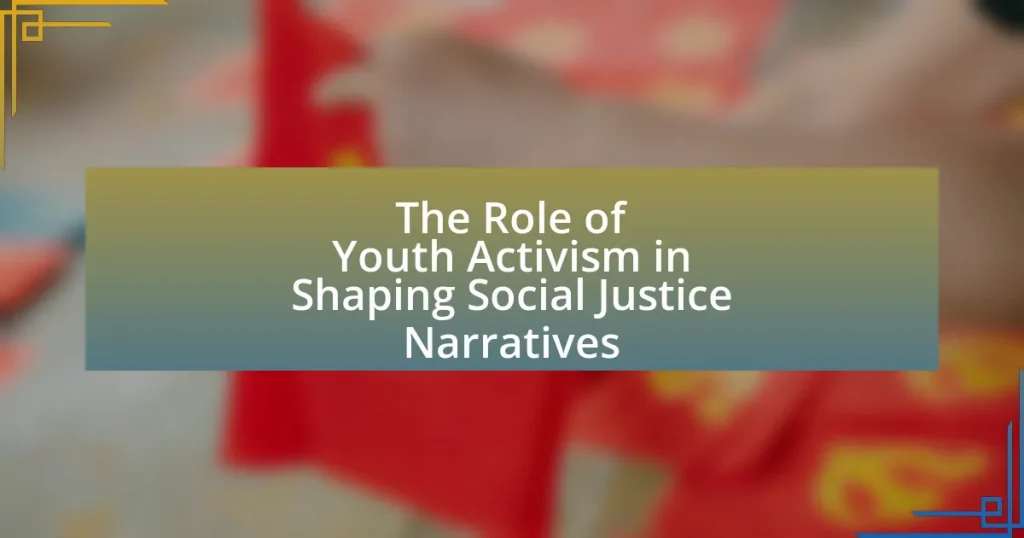The article examines the impact of social media on voter turnout in modern elections, highlighting its role in enhancing political engagement and mobilizing younger voters. It discusses how social media platforms serve as effective tools for disseminating information about voting procedures, candidates, and issues, leading to increased participation rates. Key factors influencing voter turnout through social media, such as engagement, information dissemination, and targeted mobilization efforts, are analyzed, along with the effects of misinformation on voter perceptions and decision-making. The article also explores historical trends in voter turnout, the significance of high participation rates, and strategies for political campaigns to effectively engage voters through social media.

What is the Impact of Social Media on Voter Turnout in Modern Elections?
Social media significantly increases voter turnout in modern elections by enhancing political engagement and mobilizing younger voters. Studies indicate that social media platforms serve as effective tools for disseminating information about voting procedures, candidates, and issues, which can lead to higher participation rates. For instance, a study by the Pew Research Center found that 69% of adults in the U.S. use social media, and among those users, 50% reported that social media influenced their decision to vote. Additionally, targeted campaigns on platforms like Facebook and Twitter have been shown to effectively reach and motivate specific demographics, particularly millennials, resulting in increased turnout during elections.
How has social media changed the landscape of political engagement?
Social media has transformed political engagement by enabling direct communication between politicians and the electorate, fostering greater participation and activism. Platforms like Twitter and Facebook allow candidates to share their messages instantly, bypassing traditional media filters, which has led to increased voter awareness and mobilization. For instance, during the 2008 U.S. presidential election, Barack Obama’s campaign effectively utilized social media to engage younger voters, resulting in a significant increase in voter turnout among that demographic. This shift has also facilitated grassroots movements, as seen in events like the Arab Spring, where social media played a crucial role in organizing protests and raising awareness.
What role does social media play in informing voters about elections?
Social media serves as a crucial platform for informing voters about elections by providing real-time updates, facilitating discussions, and disseminating information about candidates and policies. It enables users to access diverse viewpoints and engage with electoral content, which can enhance their understanding of the electoral process. According to a Pew Research Center study, 53% of social media users reported that these platforms helped them learn about candidates and issues during elections. This highlights the significant role social media plays in shaping voter awareness and engagement in the electoral landscape.
How does social media influence voter perceptions and opinions?
Social media significantly influences voter perceptions and opinions by shaping the information landscape and facilitating engagement. Platforms like Facebook and Twitter allow users to access diverse viewpoints, which can alter their understanding of political issues and candidates. Research indicates that 62% of voters reported that social media impacted their voting decisions, highlighting its role in shaping public opinion. Additionally, algorithms prioritize content that resonates with users, often reinforcing existing beliefs, which can lead to echo chambers that skew perceptions. This dynamic underscores the importance of social media as a powerful tool in modern electoral politics.
Why is voter turnout important in modern elections?
Voter turnout is crucial in modern elections because it directly influences the legitimacy and representativeness of the electoral outcome. High voter turnout indicates that a larger segment of the population is engaged in the democratic process, which enhances the credibility of elected officials and policies. For instance, the U.S. presidential election of 2020 saw a turnout of approximately 66.8%, the highest in over a century, reflecting increased public interest and engagement, often attributed to social media campaigns that mobilized voters. This engagement is essential as it ensures that diverse perspectives are represented in governance, leading to more comprehensive and effective policy-making.
What are the historical trends in voter turnout?
Voter turnout has historically fluctuated, with significant trends observed in various elections. For instance, in the United States, turnout for presidential elections has ranged from a low of about 49% in 1996 to a high of approximately 66% in 2020. Midterm elections typically see lower participation, with turnout around 36% in 2014 and 50% in 2018. Factors influencing these trends include changes in voting laws, demographic shifts, and the increasing role of technology and social media in mobilizing voters. The U.S. Census Bureau and the Pew Research Center provide data supporting these trends, highlighting the impact of social engagement and outreach efforts on voter participation rates.
How does voter turnout affect election outcomes?
Voter turnout significantly affects election outcomes by determining which candidates or measures are likely to win. Higher voter turnout often favors candidates who appeal to a broader demographic, while lower turnout can lead to victories for candidates with more niche support. For instance, in the 2008 U.S. presidential election, a turnout of approximately 61.6% contributed to Barack Obama’s victory, as he mobilized younger and minority voters who were previously underrepresented. Conversely, in elections with lower turnout, such as the 2014 midterms where only about 36.4% of eligible voters participated, the outcomes often reflected the preferences of a more limited voter base, typically older and more conservative. This demonstrates that turnout not only influences the immediate results but also shapes the political landscape by affecting policy priorities and representation.
What are the key factors influencing voter turnout through social media?
Key factors influencing voter turnout through social media include engagement, information dissemination, and mobilization efforts. Engagement is driven by interactive content that encourages users to participate in discussions and share their opinions, which can increase their likelihood of voting. Information dissemination occurs when social media platforms provide timely updates about elections, candidates, and voting procedures, making it easier for users to access essential information. Mobilization efforts, such as targeted advertisements and reminders to vote, have been shown to significantly boost turnout; for example, a study by the Pew Research Center found that social media campaigns can increase voter participation by up to 10%. These factors collectively enhance awareness and motivation, leading to higher voter turnout.
How do social media campaigns mobilize voters?
Social media campaigns mobilize voters by leveraging targeted messaging and community engagement to increase awareness and participation in elections. These campaigns utilize data analytics to identify and reach specific demographics, ensuring that messages resonate with potential voters. For instance, a study by the Pew Research Center found that 69% of adults in the U.S. use social media, making it a powerful tool for disseminating information about voting dates, candidate platforms, and registration processes. Additionally, social media platforms facilitate grassroots organizing, allowing users to share content, mobilize friends, and create events, which can significantly enhance voter turnout.
What demographic groups are most influenced by social media in elections?
Young voters, particularly those aged 18 to 29, are the demographic group most influenced by social media in elections. Research indicates that this age group is highly engaged with platforms like Instagram, TikTok, and Twitter, which serve as primary sources of political information and mobilization. According to a study by the Pew Research Center, 50% of young adults reported that social media significantly impacted their voting decisions in the 2020 U.S. elections. Additionally, minority groups, including Black and Hispanic voters, also show substantial influence from social media, as these platforms often amplify issues relevant to their communities and facilitate grassroots organizing.
How does misinformation on social media impact voter turnout?
Misinformation on social media significantly decreases voter turnout by creating confusion and distrust among potential voters. Studies indicate that exposure to false information can lead to apathy or disillusionment regarding the electoral process, as individuals may feel their votes do not matter or that the system is rigged. For instance, a 2020 study by the Pew Research Center found that 64% of Americans believed misinformation had a major impact on their understanding of the election, which correlates with lower engagement levels. Additionally, misinformation can mislead voters about voting procedures, such as registration deadlines and polling locations, further hindering participation.
What are the common types of misinformation encountered on social media?
Common types of misinformation encountered on social media include false information, misleading headlines, and fabricated content. False information often involves incorrect facts or statistics that can mislead users about political candidates or policies. Misleading headlines may exaggerate or distort the actual content of articles, leading to misinterpretation. Fabricated content consists of entirely invented stories presented as news, which can significantly influence public perception and voter behavior. According to a study by the Pew Research Center, 64% of Americans believe that fabricated news stories cause confusion about the basic facts of current events, highlighting the pervasive impact of misinformation on social media.
How can misinformation affect voter decision-making?
Misinformation can significantly distort voter decision-making by shaping perceptions and beliefs based on false or misleading information. For instance, studies have shown that exposure to misinformation can lead voters to make choices that do not align with their actual preferences or interests, as they may rely on inaccurate narratives about candidates or policies. A notable example is the 2016 U.S. presidential election, where research indicated that misinformation spread through social media platforms influenced voter opinions and behaviors, ultimately affecting election outcomes. This demonstrates that misinformation not only misguides individual voters but can also alter the overall electoral landscape by skewing public perception and trust in the democratic process.
What strategies can be employed to enhance voter turnout via social media?
To enhance voter turnout via social media, targeted campaigns that utilize data analytics to identify and engage specific demographics are essential. These campaigns can leverage personalized messaging and content that resonates with the interests and concerns of potential voters. For instance, studies have shown that social media platforms can increase voter turnout by up to 15% when users receive tailored information about voting dates, locations, and issues relevant to them. Additionally, employing influencers and community leaders to promote civic engagement can amplify reach and credibility, encouraging more individuals to participate in elections.
How can political campaigns effectively use social media to engage voters?
Political campaigns can effectively use social media to engage voters by creating targeted content that resonates with specific demographics. This approach allows campaigns to tailor their messages based on voter interests and behaviors, increasing the likelihood of engagement. For instance, a study by the Pew Research Center found that 69% of adults in the U.S. use Facebook, making it a prime platform for reaching a broad audience. Additionally, campaigns can utilize interactive features such as polls, live Q&A sessions, and shareable graphics to foster two-way communication, which enhances voter involvement. Engaging storytelling and authentic messaging can also build trust and connection, as evidenced by the success of Barack Obama’s 2008 campaign, which effectively leveraged social media to mobilize young voters.
What best practices should organizations follow to combat misinformation?
Organizations should implement a multi-faceted strategy to combat misinformation, which includes fact-checking, promoting media literacy, and fostering transparency. Fact-checking involves verifying claims before dissemination, as evidenced by the success of organizations like Snopes and FactCheck.org, which have effectively debunked false narratives. Promoting media literacy equips individuals with the skills to critically evaluate information sources, a practice supported by studies showing that informed voters are less susceptible to misinformation. Transparency in communication, such as disclosing sources and funding, builds trust and credibility, which is crucial in an era where misinformation can significantly influence voter behavior.
What are the future implications of social media on voter turnout?
Social media is likely to significantly increase voter turnout in future elections by enhancing engagement and mobilization efforts. Research indicates that platforms like Facebook and Twitter have already played a crucial role in informing and motivating voters, particularly among younger demographics. For instance, a study by the Pew Research Center found that 50% of social media users reported that these platforms helped them learn about the election process and candidates. Additionally, targeted advertising and grassroots campaigns on social media can effectively reach and mobilize specific voter groups, as evidenced by the 2016 U.S. presidential election, where social media strategies were pivotal in increasing participation rates.
How might emerging technologies change the way voters engage with social media?
Emerging technologies will likely enhance voter engagement with social media by enabling more personalized and interactive experiences. For instance, advancements in artificial intelligence can facilitate targeted content delivery, allowing political campaigns to tailor messages based on individual voter preferences and behaviors. According to a study by the Pew Research Center, 69% of adults in the U.S. use social media, indicating a significant platform for political engagement. Additionally, features like augmented reality can create immersive experiences that encourage voter participation and awareness. These technologies can also improve the accessibility of information, making it easier for voters to engage with candidates and issues, ultimately influencing voter turnout in modern elections.
What trends should we watch for in upcoming elections regarding social media use?
In upcoming elections, key trends to watch regarding social media use include the rise of short-form video content, increased use of targeted advertising, and the growing influence of social media influencers on voter engagement. Short-form videos, popularized by platforms like TikTok, have shown to capture younger audiences effectively, as evidenced by a study from the Pew Research Center indicating that 48% of U.S. teens use TikTok, making it a vital platform for political messaging. Targeted advertising will likely become more sophisticated, leveraging data analytics to reach specific demographics, as seen in the 2020 U.S. elections where campaigns utilized micro-targeting strategies to influence voter behavior. Additionally, social media influencers are increasingly being recognized for their ability to mobilize voters, with research from the Knight Foundation highlighting that 50% of young voters reported being influenced by social media personalities in their voting decisions. These trends indicate a significant shift in how campaigns engage with voters through social media platforms.
What practical steps can individuals take to ensure informed voting through social media?
Individuals can ensure informed voting through social media by critically evaluating sources, engaging with diverse viewpoints, and verifying information. Critical evaluation involves assessing the credibility of the information shared, such as checking the author’s qualifications and the publication’s reputation. Engaging with diverse viewpoints allows individuals to understand different perspectives and reduces the risk of echo chambers, which can distort information. Verifying information through fact-checking websites, such as Snopes or FactCheck.org, helps confirm the accuracy of claims made on social media. These steps are essential as studies show that misinformation can significantly influence voter perceptions and decisions, highlighting the importance of informed engagement in the electoral process.



